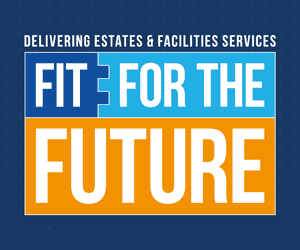As the requirements from the hospital estate change Richard Guy, Country Sales Manager for Ergotron UK & Ireland, talks to HEFMA about configuring flexible space.
In the face of a global health crisis, hospital administrators and frontline clinicians have had to respond at speed to a surge in numbers of critically ill patients. In the UK, the acute hospital, ambulance, community, and public health Trusts found themselves at the forefront of the NHS response. Meanwhile, the independent hospital sector joined forces with the NHS, pledging capacity to treat patients and help the NHS deliver urgent treatments.
The crisis has seen an unprecedented collaboration between high functioning teams across healthcare organisations and beyond, making it possible to shift services at incredible speed. As healthcare leaders prepare to re-shape care delivery models in preparation for the realities of the world we now live in, care settings will need to be designed for extreme flexibility to cope with fast changing needs.
Preparing for potential spikes in demand
Adaptive spaces that make it possible to reimagine care delivery, optimise the performance of frontline clinicians, and enhance patient/caregiver interactions will become critical. A top priority will be ensuring equipment is on hand to implement the safety and health risk controls needed to ensure continuity of care and patient flows can be maintained.
To optimise the care-giving potential of every environment, in-room and mobile workstations containing telehealth and IT equipment will be essential for giving teams instant and convenient access to medical records and the ability to make digital notes quickly and efficiently. That should also include wall-mounted monitors and systems at the point of care that make it easy to flex and optimise spaces, while providing the greatest number of staff with access to the essential equipment and information systems they need.
Optimising environments and maintaining patient flows
As healthcare organisations prepare to resume delivery of planned care, they will need to maintain a delicate balance between various healthcare demands.
To address these needs, organisations will need to ramp up their testing capacity for both staff and for the growing number of personnel attending outpatient or inpatient services. Utilising mobile carts and workstations that support the fast creation and relocation of testing stations is just the starting point for ensuring that continuity of care can be maintained.
Safety and health risk controls will need to incorporate shielding for the most vulnerable patient groups that have complex underlying health conditions, alongside the provision of adequate secure storage for PPE equipment in every patient-facing environment.
Re-framing care delivery
Healthcare leaders will need to evaluate ways to ramp up the automated delivery of alternative and remote care options - such as telemedicine and home-based monitoring – to preserve system capacity for potential future demand spikes.
For the effective and compliant delivery of these digital services at scale, clinicians will need secure spaces where they can ensure that the privacy of remote patients can be maintained during virtual consultations – and existing facilities will need to be recalibrated to support what is likely to become a long-term strategy of providing sustainable healthcare delivery options that reduce the need for patients to unnecessarily expose themselves to physical care environments.
Finally, the recent pandemic has placed personnel in just about every part of the organisation under significant personal stress. To address the wellbeing needs of teams in the aftermath of the crisis, healthcare administrators have provided more rest areas close to points of care delivery where staff can drop in and use to take a breather, grab something to eat and drink, and gather their thoughts before returning to work.
Featuring soft furnishings and calm lighting, these so called ‘wobble rooms’ feature a range of useful resources – including personal and secure storage and other resources as well as information on how to access emotional support and counselling services. With the intensity of care giving likely to increase, as staff deal with the pent-up patient demand generated by the recent lockdown of non-essential healthcare services, these rooms will continue to provide a vital oasis for staff on shifts.
Looking to the future
Administration teams will increasingly be asked to deliver highly adaptable and flexible care environments that can weather any impact and be adjusted at pace in line with fast-changing needs. Prioritising the efficient use of space and the time of care-giving teams will be vital for optimising the performance of today’s increasingly multi-disciplined teams.
With digitalisation of the healthcare environment set to escalate yet further, enabling the safe and easy access to equipment and electronic devices that are essential not only to the clinical care and management of patients – but also supports their emotional and personal needs – will rise up the list of priorities.
For the future, ensuring that equipment and people can be mobilised fast – and that the care giving environment can be reconfigured according to the individual needs of caregiving teams will enable healthcare organisations to respond at speed to any variation in delivery needs.









